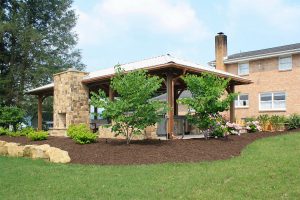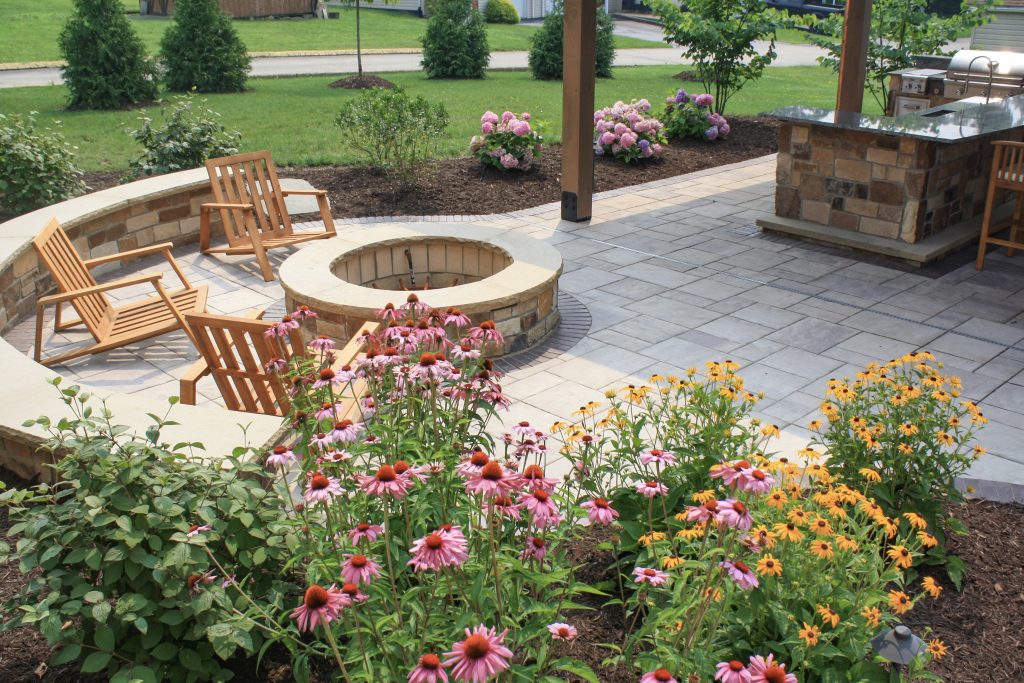At Brown Design Group, we believe the best outdoor areas are created when design and construction expertise are combined. Landscapes are not simply decorative; they are extensions of your home, created to support how you live, relax, entertain, and connect with your surroundings.
In this post, we’ll explore how intentional design, grounded in a clear vision, thoughtful connection of outdoor “rooms,” and material integrity, transforms a landscape into a space you want to use every day
The Foundation: Vision, Expertise, and Partnership
Our design philosophy begins with a principle: “How can you design something efficiently without knowing how to build it?”
Our expertise in landscape architecture sets us apart. Our team, led by a Registered Landscape Architect and supported by graduate landscape architects, bridges creative vision with technical feasibility.
But expertise alone is not enough. From the moment we begin, we treat design as a partnership. We want to know how you imagine using your outdoor space, whether for quiet reading, hosting dinner, family gatherings, or simply unwinding. That input becomes the foundation that guides every decision.
Because we lead design through to build and maintenance, our decisions are informed by what will endure—not just what looks good on paper. This continuity ensures your space maintains its integrity, flow, and character over time.
Outdoor Rooms: Defining Function Through Design
When we talk about outdoor rooms, we mean more than aesthetic zones. We mean deliberately crafted spaces that serve real function and connect in logical, comfortable ways.
Examples of Outdoor Rooms
- Dining / Kitchen Zone: A structure with built-in cooking, a bar, or prep area, ideally placed so it links directly to the home for ease of use.
- Lounge & Conversation Space: A cozy spot with seating, shade, and a transitional connection to the dining area.
- Play Zone: A putting green or play area for kids.
- Quiet Retreats: Meditation gardens, reading nooks, water features. Etc.
The strength of a design lies not in the number of zones, but in how they connect—how you move from one to another, how sightlines, materials, and transitions guide the flow.
Layout & Flow: The Invisible Architecture
A beautifully rendered drawing is compelling, but if the layout impedes use, it fails in its purpose. At Brown Design Group, we emphasize planning that aligns with your habits, priorities, and daily movements.
The layout of your outdoor space is a primary factor in determining its functionality. For example, if you want to use the space throughout the year, you can add a pergola built onto the house. Under the pergola, you can install the outdoor kitchen, bar, or grill to allow for entertaining without taking a rain check.
Once the kitchen area is established, consider where the dining zone will be located to ensure the best experience. Consider questions such as:
- Do you want the outdoor dining area in the shade or in the sun?
- How does the kitchen flow to the dining room?
- Are there stairs you need to carry dishes up and down?
- Is it in the same covered structure as the kitchen?
- How does it connect to the lounge?
Making these decisions during the design phase makes your design choices much more intentional and, in return, creates a functional and stunning space for you to enjoy.
Material Integrity & Site-Responsive Decisions
Every surface, structure, and planting decision should support the purpose, climate, and long-term performance of the space.
Hardscape & Surfaces
One example of selecting a material that aligns with the space’s function is natural stone patios, which create a unique design for each patio while also offering greater longevity than manufactured stones.
When alternative materials are chosen, such as composite decking, engineered pavers, or wood, these choices are based on maintenance expectations, climate response, and how well they complement the home’s architecture.
Planting & Landscape Elements
Plants do more than decorate—they define edges, frame views, buffer wind or sun, and provide seasonal interest. Selecting native species that thrive in the local environment supports sustainability, resilience, and lower maintenance costs. Some native plants we often use include:
- Mountain Laurel
- Rhododendron
- Black Eye Susan
- Ferns
- Dogwood
- And more!
Sound, scent, texture, and color offered by these plants become tools to further enhance the space. Whether it’s the rustling of grass or the fragrance of a flowering shrub, each detail helps to support your entire vision for the space.
Real World Example of Intentional Design: Rustic Retreat
 The Rustic Retreat project showcases how intentional design choices can create a space that is both functional and inviting. Every element was placed with purpose, ensuring the environment supports daily living and special gatherings alike.
The Rustic Retreat project showcases how intentional design choices can create a space that is both functional and inviting. Every element was placed with purpose, ensuring the environment supports daily living and special gatherings alike.
At the center of the design is a stone fireplace, positioned on the edge of the covered patio. Rather than placing it deep within the structure, this placement allows the fireplace to anchor the lounge while maintaining an open and unobstructed view outward. The fireplace becomes a visual and functional focal point, drawing people in while extending warmth to the entire covered space.
The outdoor kitchen was designed to support serious cooking and effortless hosting. Equipped with a range top, grill, warming drawers, refrigerator, sink, and even a pizza oven, this zone functions like an interior kitchen. Its location directly within the covered patio means that gatherings are not weather-dependent, and every appliance is within easy reach. This intentional layout transforms entertaining into a seamless experience, eliminating unnecessary movement and interruptions.
Outside of the covered structure, a secondary fire pit was added. This choice was deliberate: it provides guests with another option for gathering and capitalizes on the open skies for stargazing. By creating two fire-centered areas —one enclosed and one open —the design accommodates different types of use while maintaining a cohesive flow.
 Materials also played an intentional role. The natural stone of the fireplace and patio surfaces reinforces the rustic aesthetic while providing long-term durability. Warm tones, textures, and layered planting help the covered and open areas feel connected, creating an environment that is both functional and comfortable.
Materials also played an intentional role. The natural stone of the fireplace and patio surfaces reinforces the rustic aesthetic while providing long-term durability. Warm tones, textures, and layered planting help the covered and open areas feel connected, creating an environment that is both functional and comfortable.
The Rustic Retreat is an integrated sequence of spaces, including a kitchen, lounge, and open fire pit, that connect logically and support both large gatherings and quiet evenings. This is the essence of intentional design: every choice serving a purpose while enhancing the whole.
Why Intentional Design Is Essential
Without intention, a landscape can become a set of disjointed features. A dining table may be underutilized if it’s inconvenient; a lounge may sit empty if it feels too detached from the rest of the space. Over time, poor layout or mismatched materials can lead to maintenance issues, wear, and abandonment, or reduced use of certain areas.
By contrast, intentional design ensures:
- Your landscape reflects how you live
- Each space is connected, functional, and durable
- The build is informed by design and vice versa
- The result remains beautiful and valuable over the years
When design and construction knowledge merge, driven by your vision, what results is not just a pretty yard, but a desirable environment you’ll actually use, enjoy, and maintain.
Ready to Experience the Difference? Call Brown Design Group Today!
At Brown Design Group, every project begins with understanding how you want to use your space and shaping a design that supports your vision. From the initial consultation through to build and ongoing care, our team is here to guide you through the process.
Contact us today to start planning an outdoor space that feels purposeful, connected, and uniquely yours!
With over 25 years of experience, Brown Design Group has become a trusted name in Pittsburgh for creating stunning outdoor spaces and building lasting client relationships. Led by founder George Brown, the team includes talented landscape architects, designers, craftsmen, and project managers who are passionate about transforming outdoor visions into reality through a personalized, collaborative approach.
Latest posts by Brown Design Group
(see all)

 The Rustic Retreat project showcases how intentional design choices can create a space that is both functional and inviting. Every element was placed with purpose, ensuring the environment supports daily living and special gatherings alike.
The Rustic Retreat project showcases how intentional design choices can create a space that is both functional and inviting. Every element was placed with purpose, ensuring the environment supports daily living and special gatherings alike. Materials also played an intentional role. The natural stone of the fireplace and patio surfaces reinforces the rustic aesthetic while providing long-term durability. Warm tones, textures, and layered planting help the covered and open areas feel connected, creating an environment that is both functional and comfortable.
Materials also played an intentional role. The natural stone of the fireplace and patio surfaces reinforces the rustic aesthetic while providing long-term durability. Warm tones, textures, and layered planting help the covered and open areas feel connected, creating an environment that is both functional and comfortable.